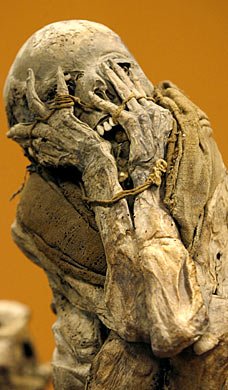The Secret Service puts the screws to a counterfeiting scholar down Al'bamey way.

By KAREN TOLKKINEN
Staff Reporter
A Clarke County student's presentation to his economics class about the U.S. Treasury went awry last month, and the teenage boy ended up being questioned by the Secret Service.
Economics class? I wonder what the nature of his presentation was. Simply noting it was about the U.S. Treasury is way too vague.
The student, whom authorities did not identify because he is a juvenile, had printed a sheaf of $10 bills on a "simple, cheap printer," said Thomas P. Impastato, resident agent in charge of the Mobile office of the Secret Service.
Oh, oh, Mr. T-Man! Competition!
What actually sent me on my nascent quest to Libertarianism and eventually Austrian economics in my teenage years, besides drunken-driving roadblocks in Indianapolis, were two books. "The Warmongers" by Howard Katz and "The International Man" by Douglas Casey. They opened my eyes to a world I had not at that point realized existed. What struck me about each book (the best quarter dollar I ever invested in was the combined purchase price of these two books) is the illuminating notion that a nation's currency controls and printing operations are tied in directly to the amount of liberty the inhabitants of that nation enjoy. Katz, in a break from exposing the funneling of assistance and technology from the American taxpayer to the Soviet bureaucrat, even took time to discuss the Ithaca dollar. From each, I was pointed to Antony Sutton's books, from there to Rothbard, and from Rothbard to Mises.
The boy gave them to classmates at Clarke Preparatory School in Grove Hill because the presentation requirements included a handout, officials said. Afterward, however, he failed to collect the bills. A student tried to spend one at a country store in Whatley, saying he had gotten it from his school lunch room, according to a Clarke County Sheriff's Department report.
This Christmas, I purchased for the Missus the DVD special edition of "To Live & Die In L.A.". It's a thoroughly engrossing depiction of one chaotic month in the lives of two U.S. Secret Service agents in Los Angeles and their attempt to collar the counterfeiter who put the kabosh on the heartbeat of the senior agent's former partner. So thoroughly did director William Friedkin plunge his story into the world of counterfeiting that the production team actually counterfeited hundreds of thousands of dollars (a still from the scene is pictured above). Friedkin, shooting without permits in the first place, later found several of his production crew in hot water with the Treasury after a few of the bills weren't destroyed and the teenage son of the co-producer got into his father's lockbox and tried to spend some of the bills. The story is included in the illuminating documentary contained in the DVD's special features. Austrians, libertarians, and gold standard advocates who possess a DVD player really ought to get this one for their collection.
"It was a darker color and whoever done it, it wasn't too good a counterfeit," said store owner Robert Edward Garrick, who expressed displeasure that such activity was taking place in a school. "It looked like two bills had been stuck together. It wasn't lined up."
Garrick said he made the student wait there while he called law enforcement.
Snitch.
In early December, the Secret Service, whose job is not only to protect the U.S. president but the money supply, interviewed the boy who made the bills, his mother, the school headmaster and the teacher, Impastato said. The federal investigator was accompanied by Clarke County deputies, he said.
"It wasn't too good a counterfeit". Remember that? Because counterfeiting clearly wasn't the intent. If this kid is fined or spends a day in jail, it's a miscarriage of justice.
The Secret Service has turned the matter over to local investigators because the boy is a juvenile, Impastato said. The Clarke County investigator, Virgil Chapman, said Monday that the case will probably be wrapped up this week.
The bills that Impastato showed the Mobile Register on Monday were of similar color to real cash but were obviously fake, chopped too short on the right side and with the phrase "For school purpose only" scrawled on the front. But Garrick said nothing was written on the bill he had.
Much ado about nothing. A government this paranoid is... well... government. Maybe the lad's next econ essay will be on the dangers of fiat currency or, better yet, government monopoly in general.
Federal law allows color copying of U.S. currency only if:
The resulting bills are one-sided and less than 75 percent the size of the original or more than 150 percent.
All negatives or other devices used to store the image are destroyed or deleted.
The student who gave out the counterfeits in class was "just being a child and not thinking," said school Headmaster Billy Pritchett. "I guess assuming that no one would pay much attention to it or use it or think it was real."
Impastato said most of the fake bills have been collected.
"They weren't all recovered," he said. "I think there were four or five that were destroyed by being thrown away."
It really burns Impastato's wick that some of "them bills" got away. Wascally devils.


No comments:
Post a Comment